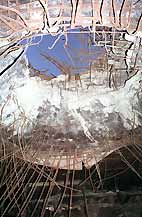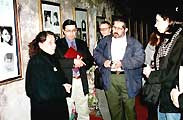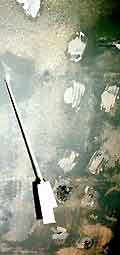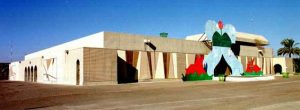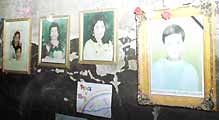Special Reports Amiria Shelter [Iraq] 1,186 victims -The scars of the bombing Hand prints and hair express the horror
Jun. 20, 2000
Sea of flames
No place to hide
I opened the iron door, which weighed about five tons and was eight centimeters (3 inches) thick. From the modern exterior reflecting the blue sky so brightly, I couldn't have imagined the interior that confronted me.
Walking a little way into the dim light, my eye was suddenly caught by a shaft of daylight streaming from a 1.5 meter hole (1.6 yards) in the roof. Light poured onto the heavily damaged floor from a gap between the ruined latticework of ferro-concrete bars bent like candy.
Around 4:30 am on February 14, 1991, during the Gulf War, about one month after the multinational force began bombing, two missiles fired in succession by US fighters tore through the two-meter (2.2 yards) thick roof and exploded over the sleeping refugees with a huge roar. Amiria Shelter stands about 15 kilometers (9 miles) west of central Baghdad. The shelter, temporary home to 1,200 elderly, women, children, and invalids from a new housing development, was instantly enveloped in flames.
"We couldn't save them because we couldn't open the iron door. The hot-water tank in the basement broke, flooding it to a depth of 1.5 meters. Some drowned in the water." Struggling with her emotion, Umm Gaida (44), one of 14 survivors, was speaking to a largely American group touring the site.
Umm Gaida survived because two hours before the bombing, she had returned to her nearby home with her eight-year-old son to do laundry. But her 13- and 6-year-old daughters, and her younger sister's family perished. Umm Gaida lost nine family members in the bombing.
Umm Gaida led us deeper into the building. She told us she became a guide to serve as witness and because "I want to stay here with the victims."
We saw several clear imprints of hands on the concrete ceiling under which triple-deck bunk beds had stood. We saw hair and skin permanently stuck to the basement walls. In the pandemonium, 1,186 lives were lost.
The US forces at first claimed, "The building we attacked was an Iraqi military base." A month later, they admitted, "It was a mistake." However, the Americans on the tour did not believe the US bombed the shelter by mistake.
Photos of the deceased hang all over the soot-covered walls of the building. Witnessing to the lost lives, the photos mutely attest to the vast destructiveness of conventional weapons in contemporary warfare, and the tragedy of war itself.
(Story and photos by Akira Tashiro)
(Originally published on June 20, 2000)

